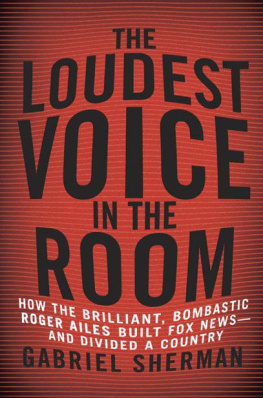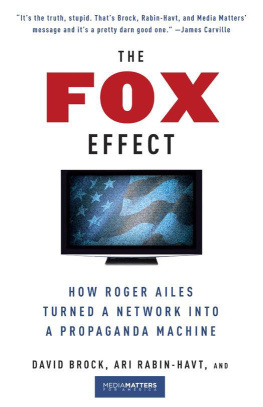A C URRENCY B OOK
PUBLISHED BY DOUBLEDAY
a division of Bantam Doubleday Dell Publishing Group, Inc.
1540 Broadway, New York, New York 10036
C URRENCY and D OUBLEDAY
are trademarks of Doubleday, a division of Bantam Doubleday
Dell Publishing Group, Inc.
Library of Congress Cataloging-in-Publication Data
Ailes, Roger.
You are the message
Roger Ailes with Jon Kraushar.
p. cm.
Bibliography: p.
1. Oral communication. I. Kraushar, Jon.
II. Title.
P95.A35 1989 89-32219
302.224dc20
eISBN: 978-0-307-81610-8
Copyright 1988 by Roger Ailes
Preface and Users Guide 1995 by Roger Ailes with Jon Kraushar
ALL RIGHTS RESERVED
v3.1
CONTENTS
For Norma, Mom, and Joe
ACKNOWLEDGMENTS
This book is more than a recent venture. Its the result of a lifetime of learning. Id like to acknowledge many of the people who have contributed to that learning process and to this book.
First, Id like to thank J. McLain Stewart, Norma Ailes, Bill Mattasoni, Larry McCarthy, John Huddy, Kathy Ardleigh, and Kevin Hall for their time and ideas. Id also like to thank corporate speechwriter Ron Nelson for his assistance, as well as Raymond Kraftson and Graeme Howard for their ongoing support and advice.
My thanks to Debi Daly and Ileana Guinot for their help and dedication.
A personal note of thanks to my mom for teaching me to set goals, and to my dad for teaching me to never quitand to find the humor in life. Special thanks are also due to Joe Urban for his insight, research, and knowledge of communications and to Marje Ailes for her early encouragement and support.
And, finally, my appreciation to my collaborator and colleague, Jon Kraushar, without whom this book would not have been written.
R OGER A ILES
PREFACE
The passage of a few years and the benefit of experience continue to prove that the principles of this book are timeless and that they work for everyone, regardless of gender, age, status, political affiliation, or nationality. Just after You Are the Message was first published, the books ideas were subjected to a public trial by fire when I served as the senior media adviser to Vice President Bushs successful 1988 presidential campaign. In that campaign, I worked with George Bush on the skills you can read about here: how to effectively combine your substance and style to get what you want by being who you are, at your best.
By 1991, I had retired from political consulting to concentrate on my work with corporate and entertainment clients. I thus removed myself from involvement in the 1992 presidential campaign. However, one of Bill Clintons top advisers admitted on television that he had read You Are the Message, and I understand the book had also been read by a number of Clintons strategists.
Out of the glare of the headlines, I heard from many people who said that You Are the Message had made a difference in their lives. One woman called me from the airport in St. Louis, Missouri, and told me that the book had saved her career. She had been paralyzed with fear before a very important business presentation but had gained confidence and learned helpful techniques while reading the book during her flight.
Thank-you letters came from recent graduates who had found employment using the interviewing tips in this book. Business leaders called to order, in bulk, copies of the book to inspire and instruct their sales forces.
Members of the clergy wrote to say that their sermons had additional sparkle because of suggestions in You Are the Message. Several schools and colleges added the book to required reading lists. In fact, my niece, a college student in Toledo, Ohio, was told by a professor that shed better read You Are the Message, and he asked if she had heard of the author. Yes, she said proudly, hes my uncle.
You Are the Message has been translated into foreign languages. However, Ive been told that the English version was used to help Eastern European entrepreneurs and government officials communicate better in their new, free-market economies after the fall of Communism.
As Ive often said, my interest in communication began with a quest to understand how and why audiences react. It is my hope that as a result of reading You Are the Message, many people will increase their understanding of the composite messages of othersfriends and foes alike. People whose messages need to be carefully analyzed include politicians, journalists, business leaders, customers, competitors, family members, teachers, public officials, and everyone else capable of changing our lives. When you think about it, that includes anyone.
It is only through study and application that we can develop the capability and control needed to be intelligent speakers andequally importantintelligent listeners. It is only through knowledge and discussion that we can sharpen our critical judgment, to distinguish between messengers who are harmful versus those who are beneficial. The message behind You Are the Message is: Take responsibility for the communication you send and the communication you receive. If theres misunderstanding either way, assume the responsibility for correcting it. Be a proactivenot a reactivecommunicator. This book teaches you how to do that.
In 1993, I turned day-to-day management of my company, Ailes Communications, over to Jon Kraushar, my longtime colleague and collaborator on this book, because I was offered a challenge too big to pass up. I was asked to run the NBC-owned cable television company CNBC and to design and launch a new all-talk network, Americas Talking, which I did on July 4, 1994. I remain associated with Ailes Communications as its founder, and Jon continues to teach the Ailes Method, as it is explained in You Are the Message. But, in returning full-time to an early passion of minetelevision productionI have new opportunities to observe and apply the lessons of this book.
Today, more than ever, we see that television, mass media, and the blooming of the Information Age have changed the way we communicate. For better and worse, we live in an age of exposure where electronic media can record, monitor, and broadcast our thoughts and actions. Whether we like it or not, societys views of people and ideas are shaped and influenced by the flickering images on television and other electronic screens worldwide, carrying video, text, and sound. It can be breathtaking, exhilarating, or frightening to watch the impact and speed of the changes wrought by those images dancing across the monitors. We have seen political systems crumble or emerge, countries collapse or form, and personal fortunes soar or crash in, literally, secondsjust as long as it took to communicate.
As it says in this book, it takes only seven seconds for you to make an impression on other people. Ours is an era in which both information and interpretation keep getting more tightly compressed. That seven seconds is crucial in the making and breaking of impressions, relationships, sales, and decisions that affect the direction of our lives. Again, like it or not, a communication symbol of our age is the easily distracted, time-stressed television viewer using a remote control device to channel surf from program to programfrom personality to personalityin mere seconds, in search of some gratifying mix of entertainment, inspiration, and information. That same restless, opportunistic viewer mentality confronts each of us as we present ourselves and our ideas to audiences small and large.









